by Jan Wecowski
Abstract
This article presents for the first time Chopin’s usage of Polish religious folklore as raw material for his music. Chopin was exposed to this repertoire from his early childhood, in 1825-26 he worked as an organist for the “Wizytki” convent in Warsaw. His Polish childhood and youth provided him with ample exposure to a vast repertoire of religious songs some of which reappear in his works from the mature period. The composer drew from serious, expressive and dramatic songs, but was particularly attached to Marian songs of a patriotic character. The texts of these songs seem to have provided a creative inspiration; the source material included motives, phrases, and larger formal units. He borrowed these elements mostly from the beginnings and endings of the songs; all borrowed material was subjected to modifications, e.g. changes of directions and sizes of leaps, interruptions of themes with pauses, superimposition of motives from several songs. Melodies appear in counterpoint, with changed intervallic structure and various motivic transformations. Quotations of religious songs cited in this study come from Śpiewnik Kościelny i Dodatki [Church Songbook and Additions], ed. Michał Marcin Mioduszewski, published in 1838-1854. The musical examples are based on the edition of [F. Ch. – Complete Works], eds. Józef Ignacy Paderewski, Ludwik Bronarski, Jerzy Turczyński, Kraków: PWM, vol. 2 (1949), vol. 7 (1957), vol. 18 (1959), vol. 5, (1961). There are religious-song-sources for Nocturne in E flat major, op. 9, no. 2; Scherzo in B minor, op. 20; Bolero in A minor, op. 19; Cantabile in B flat major, op. 43; Etude in A minor, op. 25, no. 4; Etude in C sharp minor, op. 25, no. 7; Etude in A minor, op. 25, no. 11; Largo in E flat major, WN 61, Song no. 9 “Melodia” , op. 74. The copyright of this article remains with the author.
Article
The Chopin bibliography is vast. Many works—both Polish and foreign—are devoted to folk music and its occurrence in the compositions of Fryderyk Chopin. Yet, to date, not a single scholar has considered the Polish religious songs used by Chopin in his works. Only the quotations of the Christmas carol, Lulajże Jezuniu (in the B minor Scherzo, Op. 20) and the hymn, Boże coś Polskę (in the E-flat major Largo) are commonly known. In this essay, I consider the occurrence of religious folklore—that is, Polish sacred songs—in the compositions of Fryderyk Chopin, introducing the problem here for the first time.
Chopin came into contact with religious songs already during his childhood, as much in church as at home. We know that religious songs were performed in Polish homes as early as the sixteenth century. They were sung in the morning, but especially in the evening. During the years 1825-26 Chopin was the organist at his liceum. “I play the organ each week on Sunday at the Church of the Visitation, and the rest sing.”[1] Chopin accompanied the performed religious songs and intoned them. [2] It is important to remember that Chopin spent the better part of his life—more than twenty years—in Poland. During this long period, on Sundays and on religious holidays the whole family participated in church services. In Poland—unlike in other Catholic countries— songs collectively sung by everyone in the vernacular took up a large portion of and played an important role in services as well as the liturgy of the Mass (even in defiance of Church laws!). An affection for religious songs was common in Poland. They were created by both talented amateurs and professional poets (Kazimierz Brodziński, Alojzy Feliński, Antoni Górecki, Franciszek Karpiński, Jan Kochanowski, Józef Dionizy Minasowicz, Wincenty Pol, Piotr Skarga, Józef Bohdan Zaleski) and composers (Karol Antoniewicz, August Freyer, Karol Kurpiński, Wincenty Ferdynand Lessel, Stanisław Moniuszko, Wilhelm Troszel and others).
Did Chopin remember these songs during the later years of his life? The facts prove that he knew them well and that they were dear to him. From his earliest years as an emigré; he wished not only to remember, but above all, to understand, experience, and to enter into the soul of Polish music—that is, Polish folklore (including religious songs). It might suffice to cite an early letter from Paris to Tytus Woyciechowski written December 25, 1831. “You know how much I wanted to feel—and, in part, succeeded in feeling—our national music.”[3] In April 1874, in a letter to his family he states: “I spent the evening at home playing, humming tunes from the Wisła.” (2: 194). It is very likely that religious songs were also hummed at the time. It is also worth remembering the reflections he shared with Wojciech Grzymała in a letter sent from Edinburgh on October 30, 1848: “Meanwhile, what has become of my art? And my heart, where have I wasted it?…I scarcely remember any more how they sing at home.” (2: 285). Certainly he remembered them very well. I have reason to believe, even, that he remembered more religious songs, and that they were better preserved in his memory. For there is no doubt that Chopin held dear to him everything that reminded him of Poland: his family, his happy childhood and adolescence, and therefore also Polish folklore (both secular and religious) with which he was involved on a daily basis in his native land. It seems that Polish religious songs were emotionally and ideologically precious to him.
Religious Songs – Chopin’s Inventive Creations
Chopin often drew from a rich fund of Polish religious folklore. Religious songs were a source of invention for him, creative material, the substance of new works. This was not in any way some kind of “subconscious activity.” Were the used materials quotations, borrowed motives, or merely conscious reminiscences? What does one call them? I will not try to define them. Chopin did not think in such categories. Spontaneously—according to need, invention, inspiration—he took advantage of a rich source well known to him, namely, the fund of Polish religious songs. Most often he turned to serious, expressive, and dramatic songs, but he also did not avoid simple works with an emotionally religious undertone. Marian songs of a patriotic nature were especially favored. It is no wonder, then, that in London during the fall of 1848 bid farewell to his friend Stanisław Egbert Kozmian, who was returning to Poland, with this statement: “My public career is over. You have a little church in the village; give me a modest wage allowance to live out my remaining days and I’ll play you hymns on the organ in honor of our Lady of the Polish Crown.” [4]
It also seems that song texts played an equally important role. Songs texts sometimes provided creative inspiration, were perhaps even involved in the creative act. Melodic motives, phrases, and musical periods were source material for Chopin. He usually drew from the beginning or ending of a song, sometimes from the refrain. Source material underwent creative composition. Most often this involved rhythmic and melodic modifications: change of the first or last pitch and interval (a leap of a fourth, a sixth replaced with either a raised or lowered second, a minor seventh replaced with a major second, etc.); a theme often interrupted by rests (suspirium) or different material; or a dovetailing of motives. One also encounters the transfer of a melodic line to different voices (an exchange among voices), contrapuntal continuation of a melody, in various intervals. Already begun motives or phrases are shifted by a third or sixth (for him they were still audible). I consciously use terminology associated with “pitch” instead of “written notation” because Chopin had these songs in his astonishing memory; they were not transcribed and preserved on sheets of paper. In his thematic (motivic) work, there are obviously simple, sequential, analogous, and contrasting repetitions—a great richness, variety, uniqueness, artfulness. A motive, phrase (although it might be short and of little significance) repeated several times plays an important formal role. Generally melody is very important in his compositions. It seems to me that familiarity with, and use of song material—specifically religious songs—influenced the singing, cantilena quality in Chopin’s compositions to a great extent.
Chopin’s Compositions in which Polish Religious Songs are Used
In the following account of Chopin’s borrowings the source songs are mainly taken from Śpiewnik Kościelny i Dodatki [Church Songbook and Additions collected and edited by Michał Mioduszewski (1787-1868). Although these collections were published between 1838 and 1854, they included earlier compositions already widely well known. In the Śpiewnik, songs are notated in the C clef. I therefore present them in modern edition. I also transpose all songs to the keys of Chopin’s compositions.
The examples of Chopin’s compositions I provide come from the following edition: Fryderyk Chopin, Dzieła wszystkie, Complete Works. Ignacy Jan Paderewski, Ludwik Bronarski, Jan Turczyński, eds. Cracow: PWM, Vol. 2, 1949; vol. 7, 1957; Vol. 18, 1959; Vol. 5, 1961.
I. Marche Funebre in C minor, Op. 72, No. 2.
It is believed that this work was composed at the beginning of February in 1826. The inspiration for this work was the ostentatious funeral of the learned publicist and fervent patriot, Stanisław Staszic, that took place in Warsaw on January 24, 1826. This funeral ceremony was also an expression of national commitment. Chopin experienced it with deep emotion.
The March refers to (makes use of) an old eighteenth-century song, Salve Regina, zawitaj Królowa, which is a paraphrase of a Latin Marian antiphon. Salve, with its numerous translations and melodic versions, was very popular in Poland. There were even societies and foundations that cultivated this song during Marian holy days and mournful ceremonies. Chopin uses the four-measure beginning and the ending phrase of the song. It is conceivable that a short motive from the Latin antiphonal chant also appears in the closing fragment (variously realized). See Examples 1a, 1b, 1c).

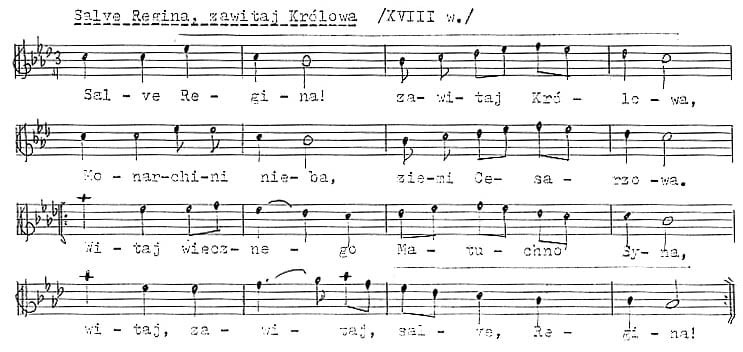
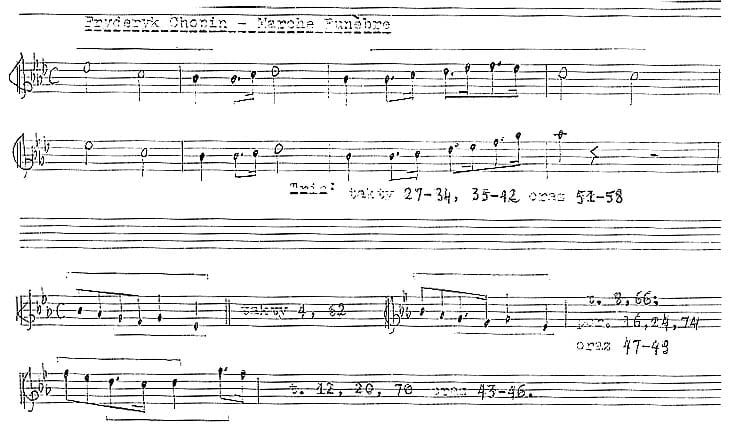
II. Nocturne in E-flat major, No. 2.
This piece was composed during 1830-31 and it was dedicated to Maria Wodzińska. According to Jane Wilhelmine Stirling’s account, the Op. 9 Nocturnes formed a part of the repertory played during lessons with Chopin. Quotations from three Marian songs can be found in the composition: Ciebie na wieki wychwalać będziemy (18th century, see example 2a), Bądz pozdrowiona Panieńko Maryja (18th century, see example 2c), and Bogurodzica (13th century; see example 2d).




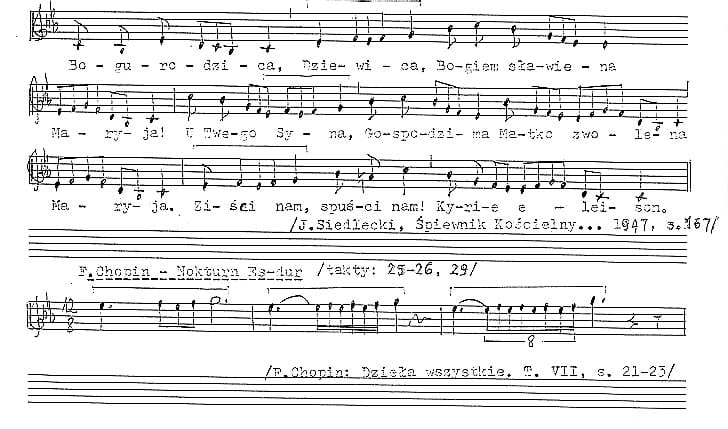
The first song has two melodies. Chopin uses the more popular melody (see example 2b). Bądz pozdrowiona is a highly patriotic song. The Polish text and melody date back to the eighteenth century. Early on—already around the year 1820 (especially among students and youth)—this melody was adapted to the song, Boże cós Polskę (already with its patriotic text), supplanting Jan Nepomucen Kaszewski’s original melody of 1816. In time (around 1861) this melody was also applied the patriotic Marian song Serdeczna Matko (and not the other way around, as is widely believed). This undeniably Polish aubade melody reveals a fortuitous similarity—the beginning phrase—with a later French melody, the aria Qu’on soit jalouse from the opera La Secret, by Jean Pierre Solie.
III. Scherzo in B minor, Op. 20 (date of composition: 1831, 1834-35).
This is a familiar example: that of the location of the melody of the Christmas carol, Lulajże Jezuniu (18th century, see example 3a), in the composition. There are two melodic versions of this Christmas carol that are confused with each other. Chopin uses the melody of the first four measures as well as the last two measures, but he changes the leap of a lowered fourth for a raised second. To date, this has gone unnoticed (see example 3b).


IV. Bolero in A minor, Op. 19 (1833).
It seems surprising that among the rich dance rhythms and march figurations there appear two, maybe even three, short melodic fragments (perhaps this is somehow the composer’s reference to the instrumental- vocal variety of the bolero form). In measures 196-200, in the lowest voice, there is a short, serious melody that is practically identical to the Lenten Polish song Ach mój Jezu, jak Ty klęczysz. An earlier fragment (measures 180-184) is even more mysterious. It is made up of four rhythmic-melodic motives, and in its entirety one can find the beginning melody of Bądz pozdrowiona (or, Boże cós Polskę), while the lowest voice of the right hand realizes the plaintive melody Dobry Jezu, a nasz Panie, kaj im wieczne spoczywanie. Textually and melodically the song refers to a Latin plaintive sequence from the Middle ages (12th/13th centuries). The Polish translation of Dies irae is by Stanisław Grochowski (1599).
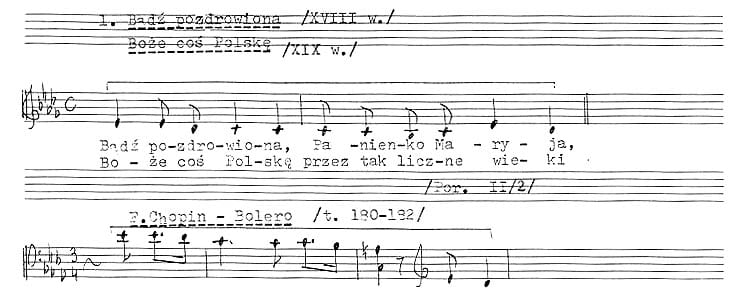
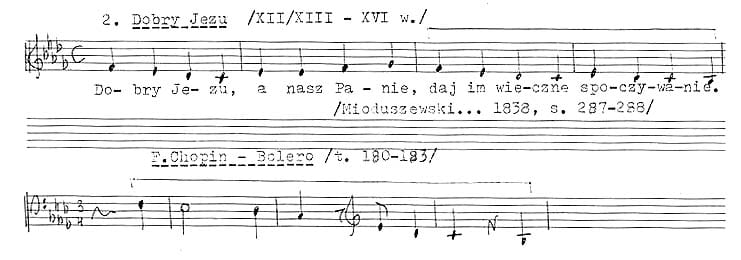

V. Cantabile in B-flat major, Op. 43 (1834).
In this short 14-measure piano miniature, march-like chords play a certain conspicuous role in the left hand. (mm.4-5, 12-13 with chromatic counterparts in mm.8-9 and 10-11). Here one can decipher the ending phrase of the Marian song Bądz pozdrowiona, Panieńko Maryja (or the hymn Boże coś Polskę with its other melody). Examples are found below.
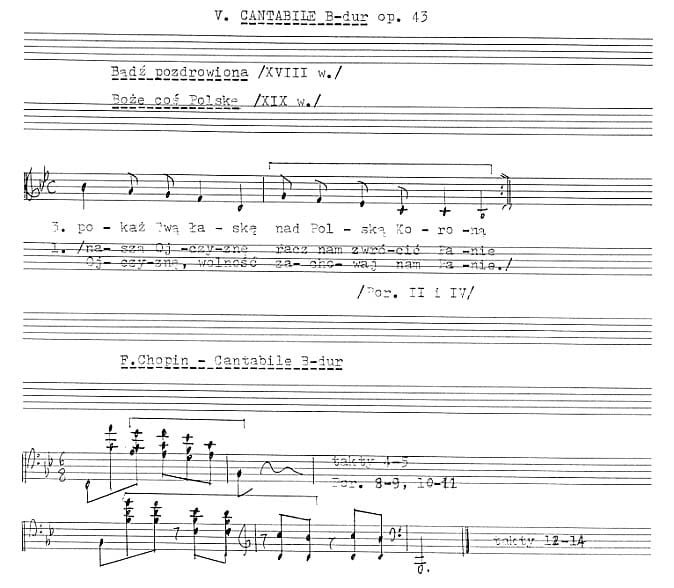
VI. Etude in A minor, Op. 25, No. 4 (before 1837).
The melody of the Marian song Matko Najświętsza—notated in songbooks from the beginning of the 19th century—winds its way through this entire work. Two main motives from the song (variously presented) are realized legatomelodically and are interrupted by rests. This creates a certain suspirium, sighing, or perhaps also refers to an earlier hocket technique (the interruption of a melody by rests). It is possible that this technique might serve as the formal principle of the entire work. We encounter here a phenomenon where the later part of a phrase or motive already begun is moved down a third. The themes undergo a rich factural transformation and modulation (see example 6).
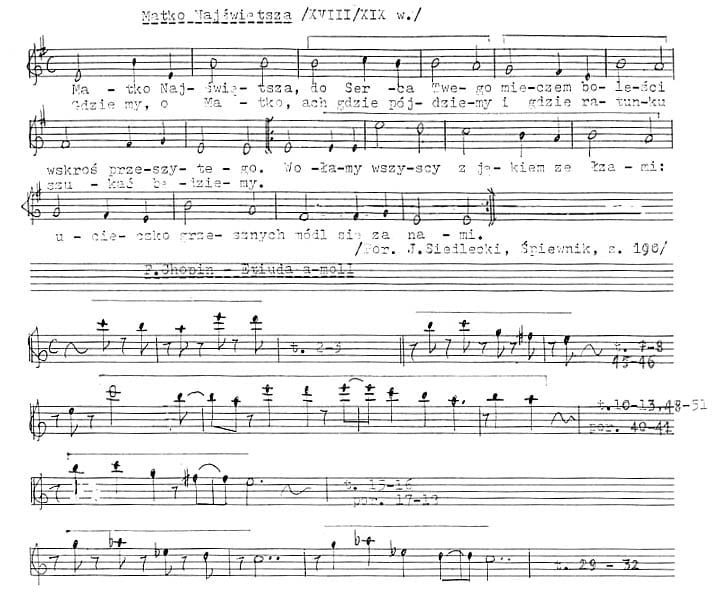
VII. Etude in C-sharp minor, Op. 25, No. 7 (before 1837).
A Christmas carol appears in this Etude (much like in the B minor Scherzo). It is a carol very well known throughout Poland and, to date, unnoticed by Chopin scholars. It is a Christmas carol/lullaby that comes from the 17th century with the incipit, Jezus malusieńki [Tiny Jesus]. Chopin treated this Christmas carol with unusual care. This was in all likelihood very dear to him. Specific melodic-rhythmic fragments of this song not only served as valuable pitch material for this work, but also as a formal foundation for the entire composition. See example 7 below.

The beginning two-measure phrase of the Christmas carol melody (which appears twice), artfully reworked (with a short imitation) appears in measures 1-4 and 46-48, and, in part, also in measures 10-12 and 54-56 (see example 7b below, or . The ending melodic fragment, also made up of two measures, found its way into measures 5-8, 49-52, as well as a fourth lower in measures 62-65. However, the short three-note melodic motive of the refrain (ascending by seconds and repeated in the Christmas carol a second higher) variously transformed (enharmonic pitches, ascending and descending), saturates the entire work, while the three-note falling melodic-rhythmic figure with a figurational ending occurs no less than eight times in measures 28-36, becoming a formal foundation for this section of the Etude. This is an unparalleled, artful basso ostinato. It is also worth emphasizing that the short introduction in the left hand, rhythmically ambiguous, is comprised of two melodies that dovetail. The first six-pitch one is a reverse canon (a retrograde imitation) of the beginning melody of the Christmas carol, while the second three- pitch motive falling by seconds refers to the rhythm of the refrain. The C sharp minor “Christmas carol” Etude should be counted/included among the most beautiful miniatures of piano literature!
VIII. Etude in A minor, Op. 25, No. 11 (before 1837).
This glorious, artful Etude, about which many—and sometimes controversial—essays have been written, is based (in my opinion) on the first part of Karol Kurpiński’s Mass, Na stopniach Twego, set to Alojzy Feliński’s text (See example 8a). This composition was published in 1822. With certainty the young Chopin played this work while serving as an organist at the Church of the Visitation. The beginning of Kurpiński’s work is a third higher (the fifth of a C major chord).
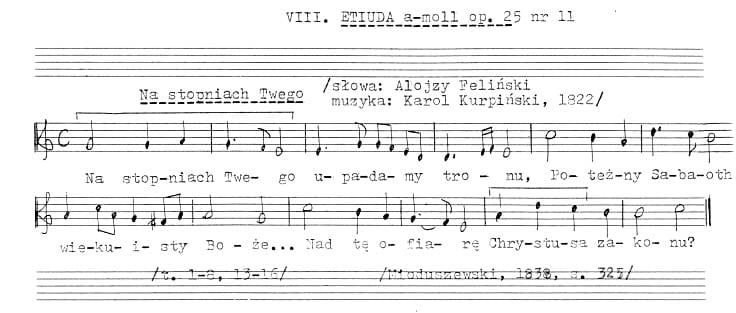
Chopin, in the key of A minor, also places his motive a third lower (the fifth of an A minor chord). The composer often moves the melody of the theme a third or sixth lower. In the third and fourth measures of the Etude, Kurpiński’s theme is fairly audible in the lowest voice of the chord in the right hand. That one should interpret the melodic theme in Chopin’s composition is suggested by the facture in measures 41-44, where the theme already occurs in its original form, in the highest voice and doubled at the octave, and is then repeated a third higher (See example 8b).
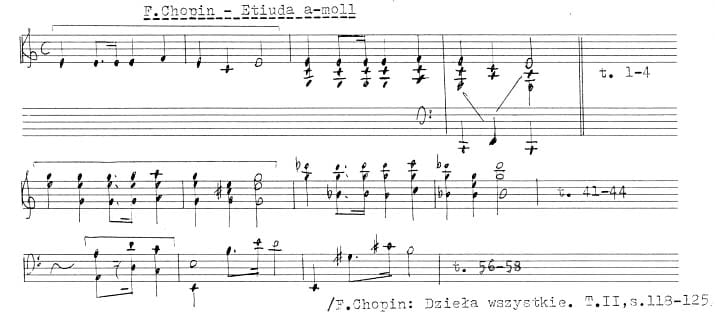
It is important to remember that this is the only place in the composition where a chord is so homophonically exposed in the right hand. My research leads me to believe that the texts of the chosen melodic themes of the song were important to Chopin. Here is the text of Kurpiński’s composition for our consideration:
On the steps of your throne we fall before you,
Oh, Mighty Sabaoth, Eternal God…
Some sort of dramatic contrast is at work here: the humble demeanor of the pleading people is set against the omnipotence of the supreme but remote “Sabaoth.” And is this not reflected in Chopin’s work? The request, at first modest, grows stronger by obstinate pleading (in the left hand), while strength, conflict, power and struggle is expressed in the forceful, violent figurations (in the right hand). Two contrasting dramatic elements saturate the entire composition. That Chopin included Kurpiński’s beginning musical motive in his own work is also evidenced perhaps by the fact that he also used a short melodic motive from the end of the song (measures 55-58 and others). This is very Chopinesque: the use of beginning and ending material from a song (source) and the use of short motives (three-pitch tones) in a clear rhythmic form.
Helena Windakiewicz, in her article “Foreign Themes in Chopin’s Music”, suggests that Chopin used the song Miała młynarka trzy córy in this Etude (see Example 8c). [6] In my opinion this is not a proper analog (the pieces are too remote) and therefore not a possible interpretation.

IX. Largo in E-flat major; WN 61.
We have Ludwik Bronarski to thank for the discovery of this composition in the Conservatory Library in Paris.[7] In this work, dated to 6 July 1838 (the year is uncertain) Chopin relies on Jan Nepomucen Kaszewski’s original 1816 melody for the hymn Boże cós Polskę. This isn’t exactly a “reworking” or “harmonization” or “arrangement” of Kaszewski’s melody as some critics have argued (especially Mieczysław Tomaszewski and Krzysztof Bilica). [8] Chopin includes only ten measures of Kaszewski’s melody (9-12, 17-20, 23-24), and avoids one entirely. He also adds a 4-note pickup, and introduces melodic, rhythmic (and harmonic) changes. Noteworthy, too, is the fact that Chopin abandons the measures where the text “naszego Króla” [our King] appears, providing instead the melody of the version that carries the text “naszą ojczyznę” [our homeland]. In addition, it is impossible to apply the traditional text of Boże cós Polskę to Chopin’s piece. It is conceivable, however, that another unknown patrio- religious text was set to Chopin’s composition. Maybe that’s where the title, “Prayer of the Poles,” comes from? Or perhaps another unknown work should be factored in? The E flat Largo, regardless, is an original piano composition by Fryderyk Chopin that refers to, or is based on a part of Jan Nepomucen Kaszewski’s work.
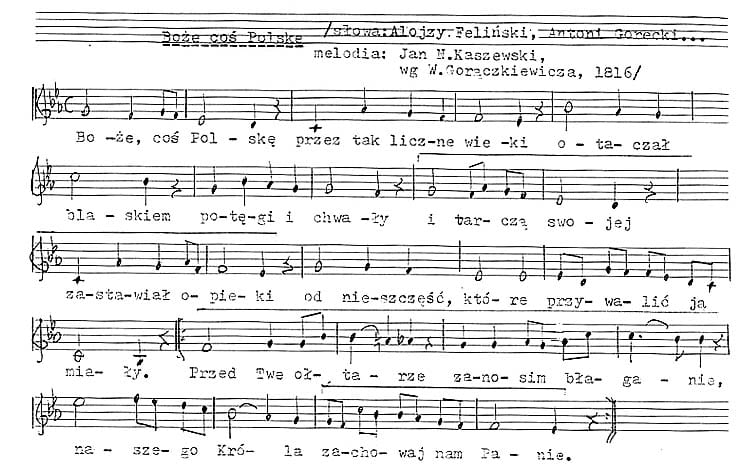

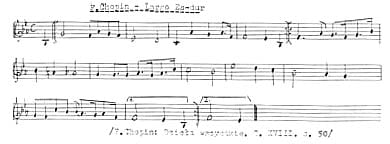
X. Song No. 9, Melodia, Op. 74; WN 90 (after May 1847).
The work Z gór, gdzie dźwigali strasznych krzyżów brzemię, [From the mountains where they carried the burden of terrible crosses] is the most artful and dramatic of Chopin’s songs. It was dedicated to Delfina Potocka. The title of the song is Julian Fontana’s. This song could also easily be titled Skarga Chopin [Chopin’s Lament]. In this work, the composer used fragments from three Polish religious songs: Żal duszę ściska [Sorrow burdens the soul], Matko Najświętsza [Holiest Mother], and Nie opuszczaj nas [Do not leave us], see example 10. It seems that Chopin hoped to underscore Zygmunt Krasiński’s text describing the Biblical desperate migration of the Israelites to the Promised Land (while also symbolizing every possible dramatic wandering, specifically that of the Poles in their search for freedom) with the texts of the religious songs he used. It should suffice to quote more of the song’s texts.
Sorrow wrenches my soul, my heart feels great pain,
When sweet Jesus readies himself to die.
Kneeling in the Garden, while his blood-stained sweat pours down,
My heart grows weak. [9]

Most Holy Mother, your heart pierced,
By the sword of suffering,
We call to thee with wailing and tears,
Refuge for us sinners, pray for us!
Where, oh, Mother, oh, where will we go
And where will we look for salvation?
Do not despise your people with petition!
Refuge for us sinners, pray for us!

This is Krasiński’s text from the ending for the song:
“and even, even perhaps they will be forgotten, forgotten, forgotten.”

With the same melodic motive Chopin illustrates the following text of the song: “Do not forsake, do not forsake, do not forsake us!” This demonstrates that not only melodic-rhythmic motives, but also the texts of religious works that Chopin used were valuable to him, and not just musically.
It should be emphasized that certain compositions by Fryderyk Chopin that suggestively include religious fragments were in various ways reworked into religious pieces almost immediately after Chopin’s compositions were published. There are a great number of such reworkings. One example is the G minor Nocturne, Op. 15, No. 3, which Chopin’s friend August Franchomme reworked into the hymn O salutaris. Chopin accepted it and stated that, “it’s easy to sing.”[10] It is possible that Delfina Potocka played this piece for Chopin while he was on his deathbed. Jane Stirling called the Op. 28, No. 20 Prelude “a prayer.” The Nocturne in G major, Op. 37, No. 1 also includes a fragment of a religious nature.
Notes
[1]. Bronisław Edward Sydow, ed., Korespondencja Fryderyka Chopina [The Correspondence of Fryderyk Chopin], vol. 1 (Warsaw: PIW, 1955), 60. [Back]
[2]. Chopin played the organ at the Church of the Visitation and later, up until he left Warsaw, he improvised and performed the organ composition of various masters and accompanied religious cantatas on this instrument under the direction of Józef Elsner. See Ferdynand Hoesick, Chopin, vol. 1 (Kraków: PWM Edition, 1967), 212-214. [Back]
[3]. Letter quoted from the Sydow edition of Chopin’s correspondence, Op. cit., vol. 1, 210. Further citations are mentioned in the text, with the volume number and page. [Back]
[4]. Kornel Michałowski, “Muzyka polska w piśmiennictwie Wielkiego Księstwa Poznańskiego,” [Polish music in writings of the Grand Duchy of Poznan], in Muzyka polska w okresie zaborów [Polish music during the period of the partitions], ed. Krzysztof Bilica (Warsaw, 1997), 158. [Back]
[5]. Stanisław Grochowski, Hymny, prozy i cantica kościelne [Church hymn, prose, and cantica] (Kraków, 1599).
[6]. Helena Windakiewicz, “Foreign Themes in Chopin’s Music” in Festchrift in Honor of Professor Adolf Chybiński (Kraków: PWM, 1950), 260. [Back]
[7]. Ludwik Bronarski, “Two Unknown Works by Chopin,” Kwartalnik Muzyczny, No. 21-22 (1948): 60-66. [Back]
[8]. Mieczysław Tomaszewski, “Chopin,” entry in Encyklopedia Muzyczna PWM (Kraków: PWM, 1985), 138; M. Tomaszewski, Chopin (Poznań 1998), 420; Krzysztof Bilica, “Melos polski u Chopina,” Muzyka No. 4 (1997): 21-23.[Back]
[9]. Tekst quoted from Mioduszewski, Śpiewnik (1838), 60-61. [Back]
[10]. Chopin’s Correspondence, ed. Sydow, vol. 2, p. 202. [Back]
Jan Węcowski studied musicology at the University of Warsaw, with Professors Hieronim Feicht and Zofia Lissa, he graduated in 1964. At present he serves as a lecturer at the F. Chopin Academy of Music in Warsaw and as the editor-in-chief of the Academy of Music Editions. He has published extensively on early music in Poland (from medieval through Baroque) and on traditional religious songs. Węcowski transcribed and edited volumes of music by Andreas Hakenberger (The Pelplin Tablature Choral Compositions: Transcriptions of Andrzej Hakenberger’s Works. Warsaw-Graz: Akademische Druck- u. Verlagsanstalt, 1970); Grzegorz Gerwazy Gorczycki (Completorium; Kraków: PWM, 1963; vol. 7 in Sources to the History of Polish Music series); Antoni Milwid (Sub tuum praesidium: 12 Cantatas for soprano, bass and instrumental ensemble; Kraków: PWM, 1979; vol. 17 in series “Sources to the History of Polish Music”); as well as Polish Passion Songs [Polske pieśni pasyjne] (Warsaw: PAX Editions, 1977). He is the author of History of Polish Religious music (in: Polish Music, vol. 56-71, 1980-1983 [Dzieje polskiej muzyki religijnej]) and many articles and book chapters. Recently he edited a volume of Christmas carols for children, Kolędować małemu [To sing carols to the small one] (Warsaw: MiGo, 1992); he also served as editor, producer, and annotator for a series of LP recordings with traditional religious repertoire for Catholic services issued by Veriton in 1960s-1980s:Gorzkie Zale. Passion Meditations, Adoramus te Christe. Śpiewy przy Bożym Grobie (chants at God’s Tomb), Polskie Pieśni Religijne (Polish Religious Songs), etc. He currently serves as the editor of the series “Pierwodruki muzyczne kompozytorów polskich” [First Prints of the Music by Polish Composers], (Warsaw, Musical Academy Editions, 1999-).